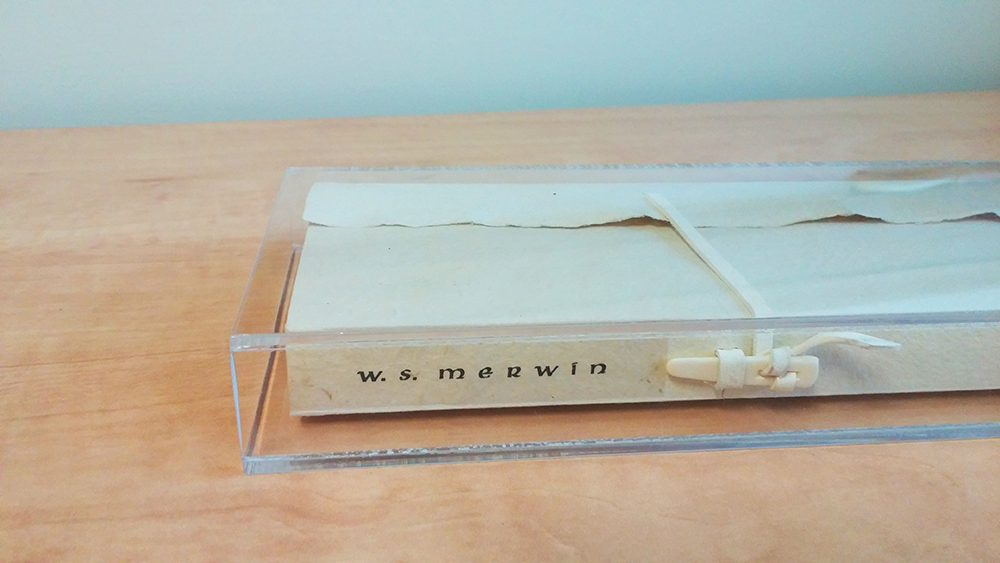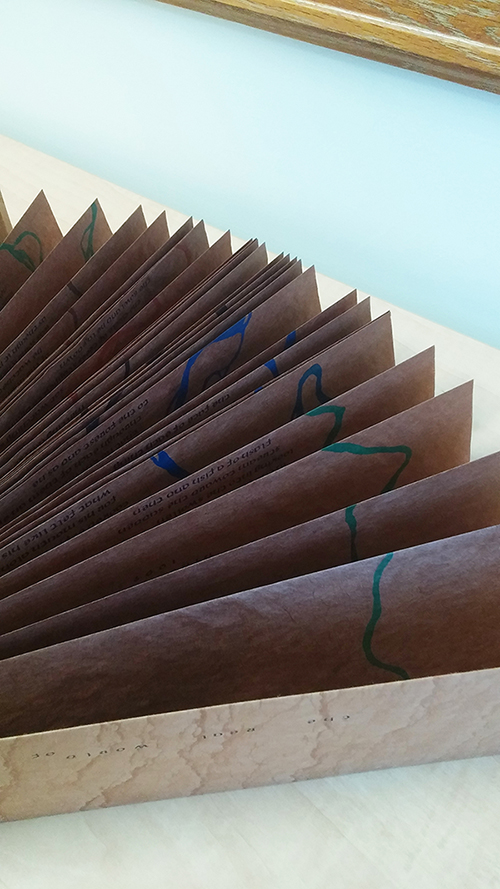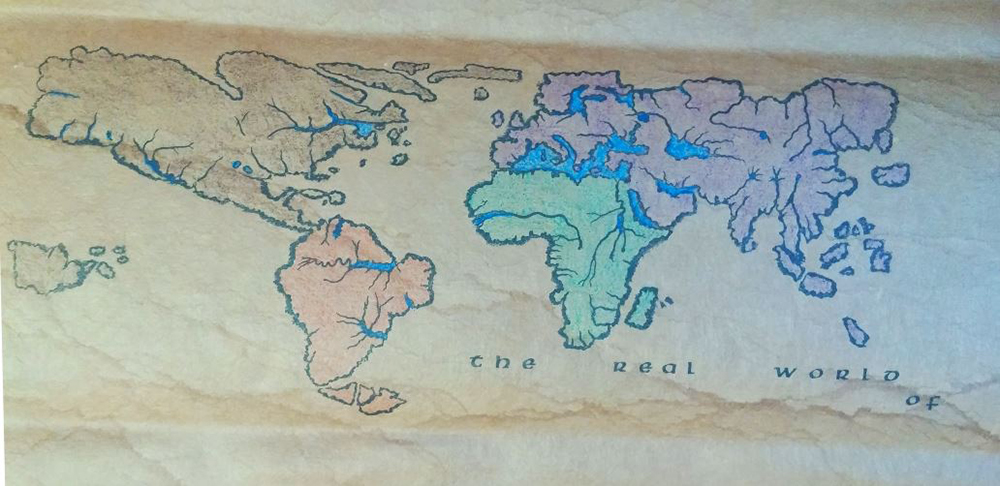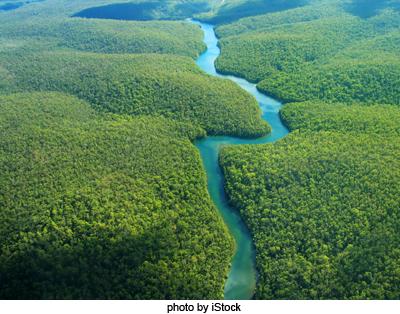
Side view of encased artist book publication of W.S. Merwin’s The Real World of Manuel Cordóva (1995).
Inside a little lacquer box sits a handmade book of W.S. Merwin’s The Real World of Manuel Córdova (1995). Something about the construction of this unconventional appearance draws me to peer beyond the damp wrinkles of a light paper enclosure to open up a long accordion of folded pages. Unlatching the pins and removing the covers, the carefully-folded pages reveal beautifully printed lines of poetry, cascading down an endless rift of delicate brown sheets of paper. Little is written on the title page other than the name of the work itself, the author and the publisher. From the soft natural-colored paper to the painted black brush stroke down the left margin, the book itself lends color and texture to elements of the natural realm.

Separated components of the artist book: (left to right) publishing and printing information; accordion-fold book of W.S. Merwin’s The Real World of Manuel Cordóva; white book enclosure.
Placed on top of the poem is a separate written statement on the printing and design work of this piece. According to this text, this special edition was created using handmade paper from the Fuji Paper Mills Cooperative in Tokushima, Japan; furthermore, the content itself was printed with hand-set Samson Uncial type. The spine of the book credits Ninja Press, an artist-run private press that has showcased its work in numerous institutions, exhibitions and private collections (Juárez 30). Bookmaker, artist and founder of Ninja Press, Carolee Campbell, works alone creating books that appeal to the experience of entering a book (32).

Top view of accordion fold structure and illustrations.
We are also presented with the image of a winding river – a minimalist brush stroke streaming down the left margin alongside the forty-three stanzas. The long poem spans 15 feet long when the accordion pages are fully expanded. I almost failed to notice the river’s seamless transitions through five different colors. It is mentioned that the world map (on the inside lining of the enclosure) mirrors the same set of colors.
Although the written work itself focuses on illustrating the journeys of Manuel Córdova-Ríos, the piece as a whole certainly calls upon elements of ecology and natural environments; in particular it captures a fluid setting within the forests of the Amazon River in 1907 (Juárez 31).

World map illustration inside book enclosure. Colored land masses mirror the ink shades of the painted river shown throughout the book.
W.S. Merwin is a highly-distinguished American Poet, having been awarded two Pulitzer Prizes in 1971 and 2009 as well as the National Book Award in 2005. By 2010, he was named the United States Poet Laureate after having produced beyond 30 written works of poetry, translation and prose in 60 years (Cohen). In the 1970s, Merwin began to explore aspects of Zen Buddhism (Cohen) and the natural environment while his writing alluded more heavily towards his concerns with biodiversity, endangered plants, animals and insects (MacGowan 138). In the 1960s, W.S. Merwin had gravitated towards writing poems with a more scarce usage of punctuation and capital letters for the purpose of enhancing “movement and lightness of the spoken word” (Cohen). We can certainly observe such notions of fluidity in the run-on narrative carried throughout the poem. With no trace of a period, comma nor capitalization, I find myself sweeping through the cascading stanzas. The words themselves dart through details of a natural landscape, as if to harness the fleeting experiences of one’s surroundings. It is difficult to place where a concrete thought begins and ends, as each statement bleeds suddenly into another:
…also he remembered
here and there the word
to which something answered
them it seemed then that he heard
his own mind and from there onward
through the forest he discovered
how much less he floundered
and crashed while they flickered
with him through the scattered
light their feet in a mastered
music never heard
not even remembered …
I did find that while skimming through the undulating text, the empty space – or margin perhaps – formed to accommodate the crease of a page interrupts this otherwise endless flow as find myself in a brief break between the lines above and below this physical demarcation. I do not believe that the stanzas would have been strategically placed all throughout the book to account for this.
…through the chant he saw his
blood in the veins of trees
he appeared in the green of his eyes
he felt the snake that was
his skin and the moneys
of his hands he saw his faces
in all the leaves and could recognize
those that were poison and those
that could save…
As a deep charcoal brown river drains into a lighter red, my imagination is met with a flurry of darker images: Merwin’s story has pressed further into fire and smoke, blood and sickness. My mind is filled with a glimpse of a lost village, a decaying, cursed landscape.
..of his ancestors he
began to be repelled by the frenzy
of their celebrations and they
who so delicately
when hunting could make the
odor of the human body
one with the unwarned
air of the forest around
them now began to offend
him with their ripened
scent they hardly listened…
At this point I cannot help but question further, who is Manuel Córdova-Ríos? As an herbologist and folk healer in the Peruvian Amazon city of Iquitos, Córdova-Ríos comes to us with a perspective of native cultures, shamanism and the notions of the supernatural (Rios 1423). As described in Merwin’s storytelling, the traveler was once a rubber cutter in Brazil, captured by Amahuaca Indians attempting to fight against rubber cutters destroying their native communities. After living among the tribes and learning their ways in horticulture and plant hallucinogens, Córdova-Ríos developed a deeper ecological awareness towards the Amazonian rainforests (1423).

The copy of W.S. Merwin’s The Real World of Manuel Córdova depicted In these photos is housed in ZSR’s Special Collections and Archives This is but one example of how the physical artistry of a book can allow us to transcend certain boundaries of textual experience. In this case we are led to unearth a story in visual and tactile exposure and sent on a journey of excavation through the winding tale of Manuel Córdova.
Works Cited
Cohen, Patricia. “W. S. Merwin to be Named Poet Laureate.” New York Times, Late Edition (East Coast) ed. Jul 01 2010. ProQuest.Web. 4 Apr. 2015.
Juárez, Miguel. “The Culture of the Book: Ninja Press at Twenty, 1984-2004.” Art Documentation: Journal of the Art Libraries Society of North America 25.2 (2006): 30-33. JSTOR. Web. 04 Apr. 2015.
Merwin, W. S., and Carolee Campbell. The Real World of Manuel Córdova. Sherman Oaks: Ninja, 1995. Print.
Rios, Marlene Dobkin De. Wizard of the Upper Amazon. Manuel Cordova-Rios, F. Bruce Lamb.” American Anthropologist 74.6 (1972): 1423-424. Web.
Macgowan, Christopher. “W. S. Merwin (b. 1927)”. Twentieth-century American Poetry: 136-138. Maldon, MA: Blackwell Pub., 2004. Print.